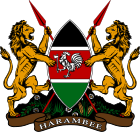| |||||||||||||||||||||
|
| |||||||||||||||||||||
Presidential election | |||||||||||||||||||||
| |||||||||||||||||||||
 Results by province | |||||||||||||||||||||
| |||||||||||||||||||||
 |
|---|
|
|
General elections were held in Kenya on 27 December 2007.[1] Voters elected the President, and members of the National Assembly. They coincided with the 2007 Kenyan local elections.
Incumbent Mwai Kibaki, running on a Party of National Unity (PNU) ticket, defeated Raila Odinga, leader of the Orange Democratic Movement (ODM) and Kalonzo Musyoka of Orange Democratic Movement–Kenya. The elections were strongly marked by ethnic hostility, with Kibaki a member of the traditionally dominant Kikuyu ethnic group, gaining much support amongst the Kikuyu and neighbouring groups in central Kenya, including the Embu and Meru. Odinga, as a member of the Luo ethnic group, succeeded in creating a wider base by building a coalition with regional leaders from the Luhya in Western Kenya, Kalenjin from the Rift Valley and Muslim leaders from the Coast Province. Kibaki was declared the winner with 46% of the vote, and was sworn in at State House on 30 December. However, opposition leader Raila Odinga also claimed victory,[2][3] and civil unrest broke out resulting in the deaths of several hundred people and the displacement of up to 600,000. This was ended by the National Accord and Reconciliation Act, which led to Odinga being appointed as Prime Minister.
In the National Assembly elections, the ODM won 99 of the 208 seats, with the PNU finishing second with 43 seats. The Kenya African National Union, which had ruled the country from independence until 2002 was reduced to being the fourth-largest party with only 15 seats. Only 71 of the 190 sitting MPs were re-elected, twenty ministers lost their seats and a record 15 female MPs were elected.[4]
There is agreement in the international community that the presidential elections were at least partially manipulated.[5] In July 2008, an exit poll commissioned by the US was released, suggested that Odinga was predicted to have won the presidency by a comfortable margin of 6%, 46% to 40%, well outside the exit poll's 1.3% margin of error.[6]
- ^ ECK sets poll date as Raila maintains lead[usurped] The Standard, 26 October 2007
- ^ Dozens dead in Kenya poll clashes BBC News, 31 December 2007
- ^ Protests as Kenya's president begins 2nd term after allegations of rigging, deadly violence Associated Press (International Herald Tribune), 31 December 2007
- ^ Election had its bright side despite the gloom[usurped] The Standard, 14 January 2008
- ^ Kenya election was rigged, U.S. envoy says CTV, 7 January 2008
- ^ US-funded exit poll says Raila won elections The Nation, 11 July 2008


